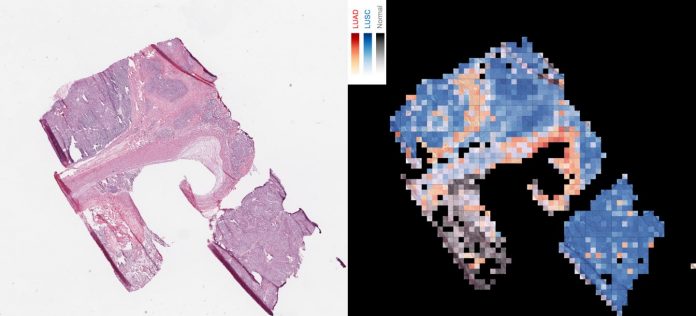
Artificial intelligence has a way of inspiring wonder and uneasiness at the same time, particularly when it shows that it can outperform humans while hiding exactly how it goes about its business. The latest group of humans to be mysteriously surpassed by artificial intelligence, or AI, consists of pathologists—specifically, pathologists tasked with inspecting whole-slide images of lung tissue and determining lung cancer type.
An AI platform developed by Google can analyze images of patients’ lung tumors, specify cancer types, and even identify altered genes driving abnormal cell growth. The platform, a deep convolutional neural network called Inception v3, was trained at New York University (NYU) School of Medicine, where the trainers—a research team led by Aristotelis Tsirigos, Ph.D., associate professor of pathology at NYU—force-fed Inception v3 slide images supplied by The Cancer Genome Atlas, a database with images of cancer histopathology images and the accompanying diagnostic annotations.
Next, the researchers put their program on automatic and measured how well it classified normal versus diseased tissue. The results of this work appeared in the journal Nature Medicine, in an article titled, “Classification and mutation prediction from non–small-cell lung cancer histopathology images using deep learning.”
The program, the researchers found, performed about as well as experienced pathologists when it was used to distinguish between adenocarcinoma (LUAD), squamous cell carcinoma (LUSC), and normal lung tissue. In addition, the program was trained to predict the 10 most commonly mutated genes in LUAD. If the training succeeded, the program would be able to identify mutations instantly, potentially avoiding the delays imposed by genetic tests, which can take weeks to confirm the presence of mutations.
“We found that six of them—STK11, EGFR, FAT1, SETBP1, KRAS, and TP53—can be predicted from pathology images, with AUCs from 0.733 to 0.856 as measured on a held-out population,” the authors of the Nature Medicine article wrote. “These findings suggest that deep-learning models can assist pathologists in the detection of cancer subtype or gene mutations.”
The genetic changes scrutinized by the NYU team often cause the abnormal growth seen in cancer. In addition, they can change a cell's shape and interactions with its surroundings, providing visual clues for automated analysis.
“We were excited to improve on pathologist-level accuracies, and to show that AI can discover previously unknown patterns in the visible features of cancer cells and the tissues around them,” says one of the article’s co-corresponding authors, Narges Razavian, Ph.D., assistant professor, department of population health and department of radiology, NYU. “The synergy between data and computational power is creating unprecedented opportunities to improve both the practice and the science of medicine.”
Determining which genes are changed in each tumor has become vital with the increased use of targeted therapies that work only against cancer cells with specific mutations, the researchers say. About 20% of patients with adenocarcinoma, for instance, are known to have mutations in the gene epidermal growth factor receptor, or EGFR, which can now be treated with approved drugs.
But the genetic tests currently used to confirm the presence of mutations can take weeks to return results, noted the study authors.
“Delaying the start of cancer treatment is never good,” emphasizes Dr. Tsirigos. “Our study provides strong evidence that an AI approach will be able to instantly determine cancer subtype and mutational profile to get patients started on targeted therapies sooner.”
Interestingly, the study found that about half of the small percentage of tumor images misclassified by the study AI program were also misclassified by the pathologists, highlighting the difficulty in distinguishing between the two lung cancer types. On the other hand, 45 out of 54 of the images misclassified by at least one of the pathologists in the study were assigned to the correct cancer type by the machine learning program, suggesting that AI could offer a useful second opinion.
Moving forward, the team plans to keep training its AI program with data until it can determine which genes are mutated in a given cancer with more than 90% accuracy, at which point they will begin seeking government approval to use the technology clinically, and in the diagnosis of several cancer types.













